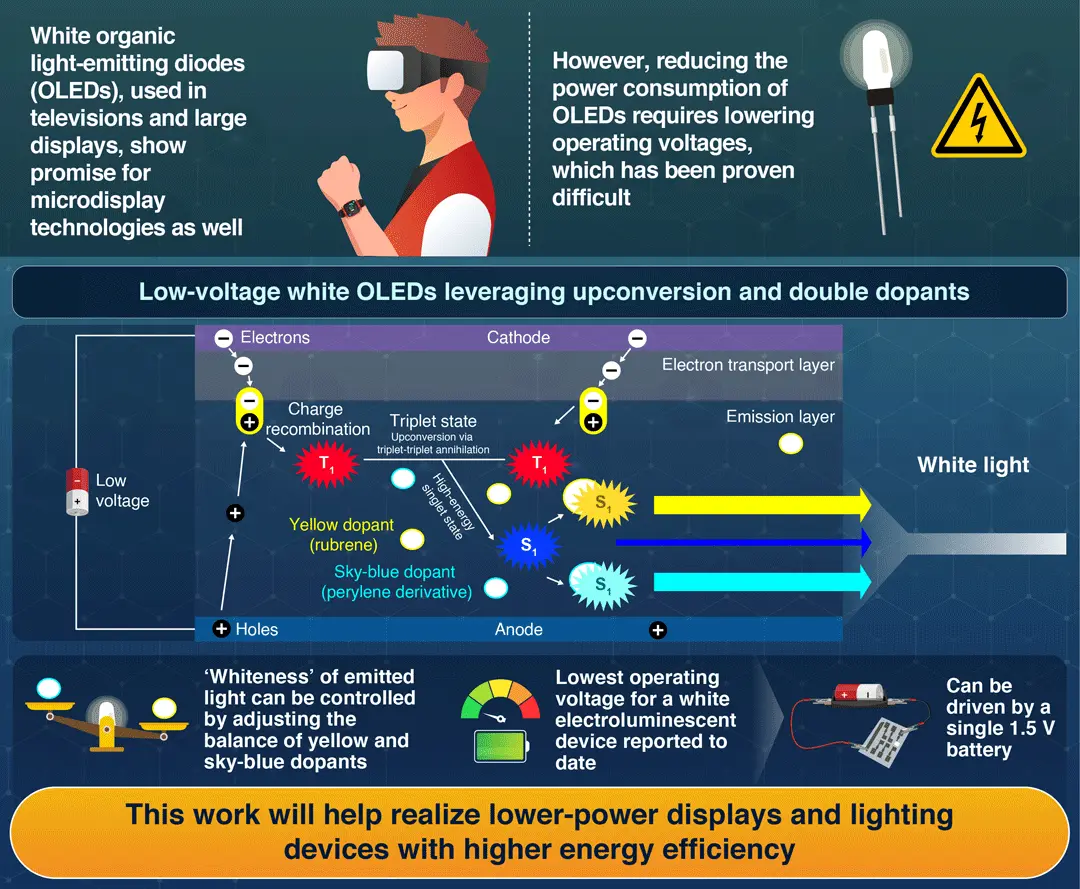Achieving the lowest operating voltage yet for white organic LEDs
A single 1.5-volt dry battery is enough to power these innovative devices, paving the way to more efficient display technologies
A newly developed white organic light-emitting diode operates at under 1.5 volts, report researchers from Institute of Japan. By using triplet–triplet annihilation to generate blue light at low voltage and adding in yellow and sky-blue dopants, the research team achieved efficient white emission. This breakthrough could contribute to reducing energy consumption in the future in state-of-the-art displays, including television backlights and lighting devices, advancing portable electronics and sustainable technologies.
Towards Energy-Efficient Microdisplay Technologies

Yang et al. (2025) | Journal of Materials Chemistry C | 10.1039/D5TC02150B
Organic light-emitting diodes (OLEDs) have revolutionized display technologies, bringing vibrant colors and sleek designs to everything from televisions and laptops to immersive virtual reality devices. Although OLEDs offer unparalleled visual quality, they still suffer from a key limitation—white OLEDs have relatively high-power consumption—that has hindered their widespread adoption in smaller, battery-operated devices.
This power-hungry nature stems from the high voltage needed to produce white light. Current white OLED technology typically requires more than 2.5 volts to operate, which is the voltage required to produce the blue light from which the white light is partially derived. Despite extensive research into improving the efficiency and color quality of white OLEDs, lowering their operating voltage has remained a significant challenge.
Fortunately, in a recent study, a research team led by Associate Professor Seiichiro Izawa from the Materials and Structures Laboratory at Institute of Science Tokyo (Science Tokyo), Japan, has achieved a remarkable breakthrough in white OLED technology. Their paper, which was published in the Journal of Materials Chemistry C on July 24, 2025, reports the successful development of a white organic electroluminescent device that operates at an unprecedentedly low voltage.
The team built upon their previous endeavors in creating low-voltage blue OLEDs using an upconversion process based on triplet–triplet annihilation (TTA). Simply put, their strategy involves using a low voltage to drive the movement of negative and positive charges within a layered organic semiconductor device. When these charges meet and recombine, they produce excited electronic states known as triplet states. These states can ‘destroy’ each other through TTA to give rise to a higher-energy singlet state, which produces blue light as it decays.
The researchers introduced two differently colored dopants into the emissive layer of the semiconductor device to achieve the desired white light: a sky-blue dopant (a perylene-based dopant, Tbpe) and a yellow dopant (rubrene). These dopants, energized by the high-energy singlet states in the host material, emit light of their respective colors as well. The resulting light is white, since yellow and blue are complementary colors. To properly tune the ‘whiteness’ of the output, the researchers had to carefully adjust the ratio of each dopant.
The newly developed white OLED boasts a turn-on voltage of less than 1.5 volts. This exceptionally low voltage requirement means the device can be directly operated by a single 1.5-volt dry battery. “To the best of our knowledge, this is the lowest operating voltage reported to date for white OLEDs,” highlights Izawa.
By enabling lower operating voltages in white OLEDs, this study could lead to new display designs in portable electronics, including wearable devices for entertainment, sports, and health applications. “Our achievement could contribute to the realization of a more energy-efficient society by enabling lower-power-consuming displays and lighting devices,” notes Izawa.
As the research team continues to refine this technology and address a few remaining challenges, such as efficiency and color stability, this work brings us closer to a future where even high-quality displays consume minimal energy.
Reference
- Authors:
- Yang Yiyan1, Qing-Jun Shui1, Hiroto Iwasaki1, Daiki Nakahigashi1, Yutaka Majima1, Ken-ichi Nakayama2, Naoya Aizawa2,3,4, and Seiichiro Izawa1*
- Title:
- White organic light-emitting diodes with extremely low turn-on voltage at 1.5 V
- Journal:
- Journal of Materials Chemistry C
- DOI:
- 10.1039/D5TC02150B
- Affiliations:
- 1Materials and Structures Laboratory, Institute of Science Tokyo, Japan
2Division of Applied Chemistry, Graduate School of Engineering, Osaka University, Japan
3Center for Future Innovation, Graduate School of Engineering, Osaka University, Japan
4Institute for Chemical Reaction Design and Discovery (WPI-ICReDD), Hokkaido University, Japan
Related articles
Furter Information
Associate Professor Seiichiro Izawa
Materials and Structures Laboratory, Institute of Science Tokyo
Contact
Public Relations Division, Institute of Science Tokyo
- Tel
- +81-3-5734-2975
- media@adm.isct.ac.jp